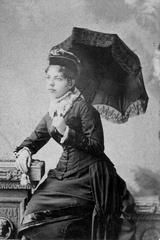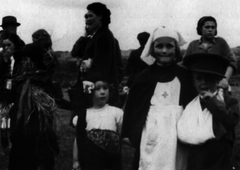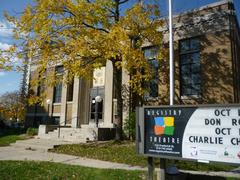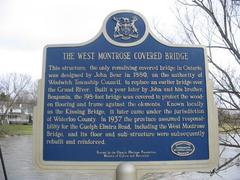Iron Horse Trail Kitchener: Visiting Hours, Tickets, and Complete Travel Guide
Date: 04/07/2025
Introduction to Iron Horse Trail in Kitchener
The Iron Horse Trail is a defining urban pathway connecting the cities of Kitchener and Waterloo, Ontario. Spanning approximately 5.5 kilometers, the trail reimagines the historic Canadian Pacific Railway corridor as a vibrant, multi-use recreational and commuter route. Open year-round and free to the public, the Iron Horse Trail invites exploration and connection, weaving together rich industrial heritage, accessible green spaces, and dynamic city life. Visitors can expect a fully paved, wheelchair-accessible experience, with routes that intersect parks, neighborhoods, and cultural landmarks. This guide delivers all you need to know—visiting hours, tickets, amenities, attractions, and the latest updates—to make the most of your visit. For further details on its origins and transformation, consult Iron Horse Trail - Wikipedia, Ontario Trails, and GVTA.
Table of Contents
- Introduction
- Historical Background & Heritage Preservation
- Visiting the Iron Horse Trail
- Modern Significance & Urban Integration
- Major Upgrades & Future Directions
- Visiting Hours, Accessibility & Tickets
- Travel Tips & Nearby Attractions
- Special Events & Photo Spots
- Frequently Asked Questions (FAQ)
- Conclusion
- References
Historical Background & Heritage Preservation
Origins & Transformation
The Iron Horse Trail traces the historic right-of-way of the Canadian Pacific Railway and the Grand River Railway. For decades, this corridor connected Waterloo and Kitchener, serving as a critical industrial artery for companies like Labatt’s and Seagram’s (lightandwheels.wordpress.com). By the late 20th century, declining rail use led to its abandonment. Recognizing its value, Kitchener and Waterloo acquired the corridor in the mid-1990s, transforming it into a public trail and preserving a tangible link to the region’s industrial past (Iron Horse Trail - Wikipedia).
Officially opened in 1997, the trail’s 5.5 km span now stretches from Erb Street West in Waterloo to Ottawa Street South in Kitchener (Ontario Trails). The route mirrors the railway’s original intent: connecting urban centers and neighborhoods, while conserving heritage through adaptive reuse.
Heritage Features
Interpretive signage along the trail narrates the region’s rail and industrial history. Industrial artifacts, preserved rail equipment, and public art installations enrich the experience, offering educational and cultural engagement (Iron Horse Trail - Wikipedia). The trail passes through historic districts, including Belmont Village and the Victoria Park area, where 19th-century architecture and streetscapes remain intact.
Community Stewardship
Kitchener and Waterloo continue to invest in trail enhancements, including lighting, widened paths, new rest areas, and safety improvements. Public input shapes ongoing upgrades, ensuring the trail meets diverse community needs (ivebeenbit.ca).
Visiting the Iron Horse Trail
Visiting Hours, Accessibility & Tickets
- Hours: Open year-round, 24 hours a day. Some sections are illuminated for evening use (GVTA).
- Admission: Free—no tickets required.
- Accessibility: Fully paved and wheelchair/stroller accessible. Gentle grades and barrier-free design make the trail suitable for users of all ages and abilities. Winter maintenance ensures year-round usability (Community Edition).
Main Access Points & Parking
- Northern trailhead: Erb Street West, Waterloo (near Waterloo Park)
- Southern trailhead: Ottawa Street South, Kitchener
- Key access: Victoria Park, Highland Courts Park, Rockway Gardens
Parking is available at major parks and along nearby streets (Ontario Bike Trails).
Modern Significance & Urban Integration
The Iron Horse Trail is more than a recreational corridor; it is an integral part of Kitchener-Waterloo’s sustainable transportation and city-building initiatives. It links major destinations—Waterloo Park, Victoria Park, regional transit hubs—and connects with the Trans Canada Trail and Laurel Trail (Iron Horse Trail - Wikipedia). The trail encourages active commuting, supports local businesses, and fosters a sense of community.
Major Upgrades & Future Directions
Significant investment is modernizing and expanding the Iron Horse Trail:
- Trail Extensions: Projects are underway to extend the trail from Ottawa Street to Sydney Street, with a new spur along Shoemaker Creek to Courtland Avenue. These enhancements will create safer, dedicated off-road paths, replacing sidewalk sections of the Trans Canada Trail (The Record).
- Creek Naturalization: Schneider and Shoemaker creeks are being restored with naturalized waterways, improving flood resilience and boosting biodiversity. This $50–$70 million project is partly federally funded and expected to be completed by 2027 (The Record).
- Urban Integration: The trail’s proximity to the ION LRT line is spurring transit-oriented developments, such as the proposed 28-storey mixed-use tower at 924–944 King Street West (Urban Toronto).
- Safety & Accessibility: Upgrades include new lighting, improved wayfinding, safer road crossings, and widened sections for diverse mobility devices.
For current construction and detour information, visit the City of Kitchener’s Iron Horse Trail page.
Travel Tips & Key Attractions
Main Attractions Along the Trail
- Waterloo Park: Playgrounds, botanical gardens, picnic spots, and the region’s oldest schoolhouse (GVTA).
- Victoria Park: Historic pond, scenic bridges, and shaded walks—ideal for rest and photography.
- Rockway Gardens: Beautiful gardens, fountains, and accessible walkways.
- Public Art & Industrial Heritage: Murals, sculptures, and preserved industrial machinery offer cultural touchpoints.
Amenities
- Benches, rest areas, and lighting throughout the trail.
- Public washrooms at major parks.
- Bike racks and water fountains at select locations.
- Nearby shops, cafés, and eateries in Uptown Waterloo and Downtown Kitchener.
Special Events & Photo Spots
The trail hosts community walks, charity runs, and seasonal festivals. Local groups occasionally organize heritage tours—check city or community calendars for schedules (Community Edition). Top photo locations include the bridges of Victoria Park, Rockway Gardens’ flower beds, and stretches with preserved rail equipment.
Frequently Asked Questions (FAQ)
Q: What are the Iron Horse Trail visiting hours?
A: Open year-round, 24/7. Some sections are lit for evening use.
Q: Is the trail free to use?
A: Yes, there are no entry fees or tickets.
Q: Is the trail wheelchair accessible?
A: Yes, the trail is paved and designed for all mobility aids.
Q: Are dogs allowed?
A: Yes, but they must be leashed.
Q: Is parking available?
A: Yes, at major parks and nearby streets.
Q: Are there guided tours?
A: Community groups sometimes host themed walks and events.
Q: Will construction affect my visit?
A: Some sections may close temporarily for upgrades—check the City of Kitchener’s official site for updates.
Conclusion
The Iron Horse Trail is a living example of heritage preservation and urban innovation. It offers a seamless blend of history, culture, recreation, and commuter convenience within Kitchener-Waterloo. Ongoing investments—trail extensions, creek restoration, and urban integration—continue to elevate its role as both a daily asset and a destination for visitors. Whether you’re a history enthusiast, nature lover, cyclist, or family adventurer, the Iron Horse Trail provides a welcoming and dynamic urban escape. Plan your visit today and experience one of Ontario’s premier urban trails.
References and Further Reading
- Iron Horse Trail - Wikipedia
- Iron Horse Trail - Ontario Trails
- GVTA Self-guided hikes: Iron Horse Trail
- Kitchener-Waterloo’s Beloved Iron Horse Trail - Community Edition
- Work to naturalize two Kitchener creeks, extend Iron Horse Trail could be complete by 2027 - The Record
- 28-storey tower proposed along Kitchener’s growing ION LRT corridor - Urban Toronto
- City of Kitchener’s Iron Horse Trail page




